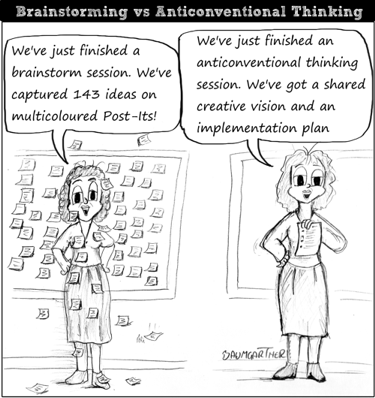
Anticonventional Thinking (ACT) versus Brainstorming
I developed Anticonventional thinking (ACT) in 2010 as a response to traditional brainstorming, a technique that has been demonstrated to be a poor way of generating creative ideas, yet which has remained the standard in business idea generation simply because it is the way it has always been done. Since first demonstrating ACT at the European Conference for Creativity and Innovation in 2011, I have led workshops in ACT, spoken on ACT, facilitation ACT session to achieve goals and have spoken about ACT globally. Each time I do something with ACT with a group, I learn a little more.
In this article, I compare brainstorming with ACT.
Philosophy
Brainstorming
The operational philosophy behind brainstorming is to generate a large quantity of ideas without worrying about quality, under the assumption that at least a few of the ideas will be creative. The number one rule of brainstorming is that there is to be no criticism of ideas during ideation.
ACT
The operational philosophy behind ACT is to set your mind to reject conventional thinking in favour of unconventional thinking when you need to be creative and to build a single creative vision in response to particular situation. In other words, ACT emphasises creative quality over quantity.
Getting Started
Brainstorming
Brainstorming, as described by Alex Osborn (who coined the phrase) does not address how to get started. However, brainstorming was eventually expanded into creative problem solving (CPS) by Mr Osborn and Sidney Parnes. CPS describes an "explore the challenge phase" that includes, "objective finding","fact finding" and "problem finding" steps. These steps serve to analyse and define the actual problem for which you want to generate creative ideas. This, in my opinion, is the best feature of CPS. People have a tendency to try and have ideas before they understand their problem correctly. Analysing and defining the problem make it more likely that relevant ideas will be suggested later. In fact, I have used this step in ACT, but have taken it further.
ACT
In ACT, a situation in which you want to take creative action is called a "transcendental situation" because it transcends most situations in which you do the conventional thing. When faced with a transcendental situation, you should not try to have ideas, but rather you should play with the situation. Bring it deep into your inner mind, explore it, change it, associate it with other situations and get to know it deeply. This helps the mind make unexpected and unconventional connections with other information.
Meditation is a great way to play with a situation in your inner mind and should be your first step -- especially when you are using ACT on your own.
In addition, when collaborating with groups, you should ask questions to understand the situation better and to broaden the mental associations you make with the situation -- this will help you to build unconventional ideas later. There are three kinds of questions to ask in ACT, analytical questions, such as those you ask in CPS; feeling questions to explore the emotional associations of the situation; and transcendental questions which are seemingly absurd questions that help you make unexpected and unconventional associations between the situation and other information in your mind. Transcendental questions might include: "What colour is the situation?", "What happens if a bunch of cats start running around in your situation?" and "What would your grandmother do in this situation?".
What's Your Problem
Brainstorming
Brainstorming uses a problem statement, typically formulated as "In what ways might we...?" The aim is to encourage divergent thinking that is still relevant to the problem.
ACT
Works with a sexy goal: one that is provocative, interesting and stimulating. It should be phrased to put the transcendental situation in a new light. For instance, instead of asking "In what ways might we improve our next generation digital cameras?" you might ask, "Describe a device that fits in your pocket and enables you to capture and share memories."
ACT encourages calls to action, such as "Design...", "Describe..." and "Make..." over requests for ideas. In addition, ACT suggests ideas be presented in the form of an image, a model or a story where possible. This facilitates visualising a creative vision as a comprehensive solution in a given situation.
Ideas!
Brainstorming
Brainstorming is very strict here. The aim is to generate as many ideas as possible. Quantity is more important than quantity. There is to be no criticism of ideas, because criticising ideas will stifle creativity. The assumption is that once people run out of boring, conventional ideas they will somehow be inspired to have creative ideas.
ACT
ACT aims to build a single creative vision by playing with ideas and testing them as possible solutions to the situation. Where brainstorming prohibits criticism of ideas, ACT encourages it, provided you follow some basic rules.
Interestingly, research has shown that when people are allowed to criticise ideas, they have more creative ideas than when they are prevented from criticising ideas. My own experience not only confirms this, but makes it clear that the only way a group can truly discuss a complex idea is by criticising and questioning it.
In ACT, boring ideas are explicitly prohibited and should always be criticised. In fact, I sometimes suggest that groups make a prohibited lines of thought list of boring, conventional ideas to avoid during the idea building phase of ACT.
Evaluating and Selecting Ideas
Brainstorming
Brainstorming and CPS are vague on evaluating and selecting ideas, stating merely that you are supposed to combine similar ideas, and chose the best. Some facilitators have elaborate evaluation processes. Some simply ask people to vote on ideas. Sadly, more often than not, this results in the selection of moderately creative ideas over highly creative ideas.
ACT
In ACT, you have only one, big, creative vision. There is no need to evaluate and select. You can go immediately to implementation.
Implementation
Brainstorming
Brainstorming and CPS are even vaguer here. It is pretty much left up to you to work out how to implement ideas.
ACT
ACT recognises that a creative vision can seem intimidating when it comes time to implement it. So, the final stage of ACT involves deconstructing the vision into a series of small, manageable steps; assigning a person to take responsibility for each step; visualising something positive about each step; and then focusing on each step one at a time, with the implementation of the creative vision as the destination on the road to implementation.
Conclusion
I obviously believe that ACT is superior to brainstorming. It is based on the loads of research that has been done since Mr Osborn first proposed brainstorming and is modelled after the way artists, composers and other creative teams collaborate.
Three criticisms of ACT that I often hear are:
-
"Brainstorming and creative problem solving have been used for years and work. You should not diverge from these established methods". In effect, they are saying "This is the way we have always done it. Do not question it." To my mind, this attitude is an anathema to what creativity is all about.
-
"Yes, ACT works for creative people, but for people in business it is different." I have my doubts about this. People in business also have a lot of creative potential. I do not believe that putting them in a room and pushing them to have lots of ideas is not the best way to access that creativity. Helping them train their minds to think anticonventionally, on the other hand, has more potential.
- "When a brainstorm does not work, it is because it is not facilitated by a trained facilitator." When a facilitator says this, I feel she is underestimating herself. She gets creative results not because brainstorming is such a great method, but because she is an excellent facilitator who is capable of bring the creativity out of groups in spite of brainstorming's weaknesses.
ACT vs Brainstorming Part 2
Paul Sloane is an established creativity author and trainer who is a firm believer in brainstorming as an effective method for generating creative ideas. He suggested we do a short debate on the topic and share the debbate on video. Kevin McFarthing, an innovation consultant, kindly offered to moderate the debate. You can watch it here.
Exploit ACT in Your Company
Would you like to teach your colleagues how to use ACT to build creative visions and viable action plans that can turn those visions into innovations? If so, get in touch! A growing number of businesses, governments and non-profit organisations around the world are discovering the innovation potential of anticonventional thinking. Use this form to start a confidential conversation about your innovation programme and ACT's potential to improve results.




